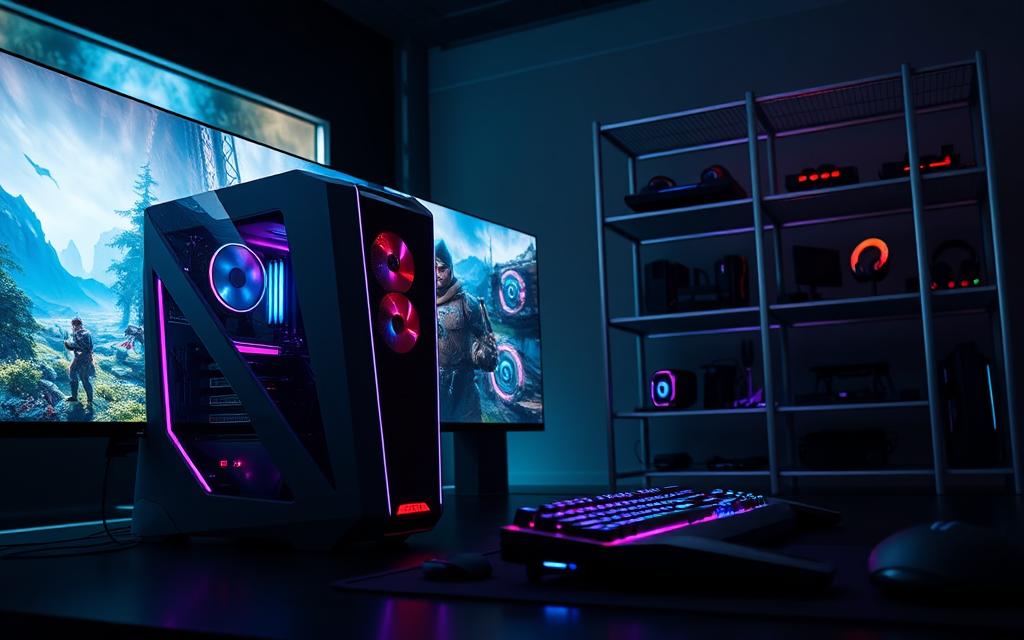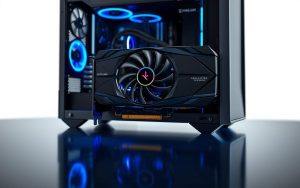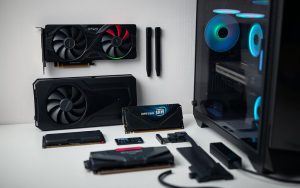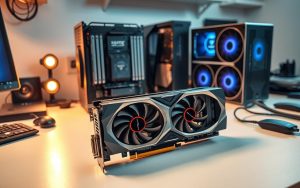Table of Contents
What’s the Price of a Good Gaming PC in 2025?
Building a powerful gaming rig in 2025 means balancing performance and budget. A quality setup typically ranges from $1,000 to $4,000, with entry-level options starting around $500. The market evolves rapidly, influenced by new tech and energy-efficient components.
Brand choices, component quality, and efficiency impact costs. High-end builds deliver smooth gameplay, while budget-friendly systems handle casual titles. PCMag’s decades of testing expertise confirm that smart investments yield long-term value.
Energy costs add $10-$20 monthly, but prioritizing performance over savings ensures better overall experience. This guide explores price tiers, brand comparisons, and future-proofing strategies for every gamer.
Introduction to Gaming PC Pricing in 2025
The gaming hardware landscape in 2025 is shaped by evolving technology and economic factors. Post-pandemic market stabilization has normalized component pricing, making it easier to plan a budget for a new rig. Next-gen GPUs like the RTX 50-series and AMD 8000-series are driving innovation, but they also influence overall system cost.
DDR6 RAM adoption is another key factor. While it offers faster speeds, it also raises baseline expenses. Balancing inflation with manufacturing efficiency trends ensures that gaming pcs remain accessible to a wide audience. Regional pricing variations in the US further complicate the picture, with some areas offering better deals than others.
Prebuilt systems, like the HP Omen 25L at $799, provide a convenient option for those who prefer simplicity. However, custom builds often offer better value, with a 5-15% premium for prebuilt convenience. Warranty considerations also vary across price brackets, adding another layer to the decision-making process.
Cryptocurrency mining continues to impact GPU availability, though its influence has diminished since its peak. Maintenance costs, such as thermal paste replacement and dust filters, are often overlooked but essential for long-term performance. Energy costs average $10-$20 monthly, making efficiency a priority for many gamers.
| Feature | Prebuilt | Custom Build |
|---|---|---|
| Cost | 5-15% higher | More budget-friendly |
| Customization | Limited | Fully customizable |
| Warranty | Comprehensive | Component-specific |
Key Components of a Gaming PC
Modern gaming PCs rely on advanced components for peak performance. Each part plays a crucial role in delivering smooth gameplay and future-proofing your system. Below, we break down the essential hardware that defines a high-quality gaming rig.
Processor (CPU)
The processor is the brain of your system. In 2025, Intel Core Ultra 9 and AMD Ryzen 9 9950X lead the pack. These CPUs handle multitasking and complex game physics with ease. For gaming, a high clock speed and multiple cores are vital.
Compatibility with modern motherboards, like AM5 or LGA1851 sockets, ensures seamless integration. Liquid cooling systems, such as those in the Corsair One i500, are becoming standard for high-end builds to manage heat efficiently.
Graphics Card (GPU)
A powerful graphics card is essential for rendering stunning visuals. The Nvidia GeForce RTX 4090 offers unmatched performance but consumes 450W. For budget-conscious gamers, the RTX 4070 Super balances power and efficiency at 115W.
PCIe 5.0 motherboards are now required to support next-gen GPUs. Real-world FPS comparisons show significant performance gaps between entry-level and high-end cards. Choose wisely based on your gaming needs.
Memory (RAM)
RAM ensures smooth multitasking and quick data access. In 2025, 16GB is the minimum for gaming, with DDR6-8000 offering faster speeds than DDR5-6400. Lower latency improves responsiveness, especially in competitive titles.
High-end systems often feature 32GB or more for future-proofing. Ensure your motherboard supports the latest RAM standards for optimal performance.
Storage Options
Fast storage reduces load times and enhances overall performance. PCIe 5.0 SSDs, with speeds up to 14,000 MB/s, are ideal for gaming. Hybrid setups, like pairing a 2TB NVMe SSD with an 8TB HDD, offer both speed and capacity.
Energy-efficient PSUs with 80+ Titanium or Gold ratings ensure stable power delivery. This is crucial for maintaining performance during long gaming sessions.

| Component | Key Features |
|---|---|
| Processor (CPU) | High clock speed, multiple cores, liquid cooling |
| Graphics Card (GPU) | PCIe 5.0 support, power efficiency, real-world FPS |
| Memory (RAM) | 16GB minimum, DDR6-8000, low latency |
| Storage | PCIe 5.0 SSD, hybrid setups, energy-efficient PSU |
What is the Price for a Good Gaming PC in 2025?
Understanding the cost breakdown of a gaming rig in 2025 helps gamers make informed decisions. The sweet spot for a high-quality system typically ranges from $1,000 to $2,500. However, premium builds like the Falcon Northwest Talon start at $3,723, catering to enthusiasts seeking top-tier performance.
Component costs play a significant role in overall expenses. Here’s a breakdown:
- GPU: 40% of the total cost
- CPU: 25%
- RAM: 10%
- Storage: 10%
- Other components: 15%
DIY builds often save money compared to prebuilt systems. For example, the MSI Codex R2 costs $1,099, while a custom build with similar specs might be 5-15% cheaper. Prebuilt systems, however, offer convenience and comprehensive warranties.
Regional pricing differences also impact affordability. In the US, deals like the HP Omen 25L at $799 are common, while EU and Asian markets may see higher costs due to taxes and import fees. Holiday sales, such as Black Friday, can further reduce prices by up to 20%.
The cryptocurrency market continues to influence GPU availability, though its impact has lessened since its peak. Extended warranties vary across brands, with some offering better coverage for a higher cost. Refurbished or used systems can save money but come with risks like limited warranties.
“Future-proofing your system ensures long-term value, but it often requires a higher initial investment.”
Hidden costs, such as monitors, peripherals, and chairs, can add hundreds to your budget. A price-per-frame analysis across GPU tiers reveals that mid-range cards like the RTX 4070 Super offer the best value for most gamers. For more insights, check out PCMag’s guide to the best gaming.
Entry-Level Gaming PCs: What to Expect
Entry-level gaming PCs in 2025 offer a balance of affordability and functionality. These systems are ideal for casual gamers or those on a budget, providing solid performance for modern titles. With prices ranging from $300 to $800, they deliver reliable 1080p/60fps gameplay without breaking the bank.
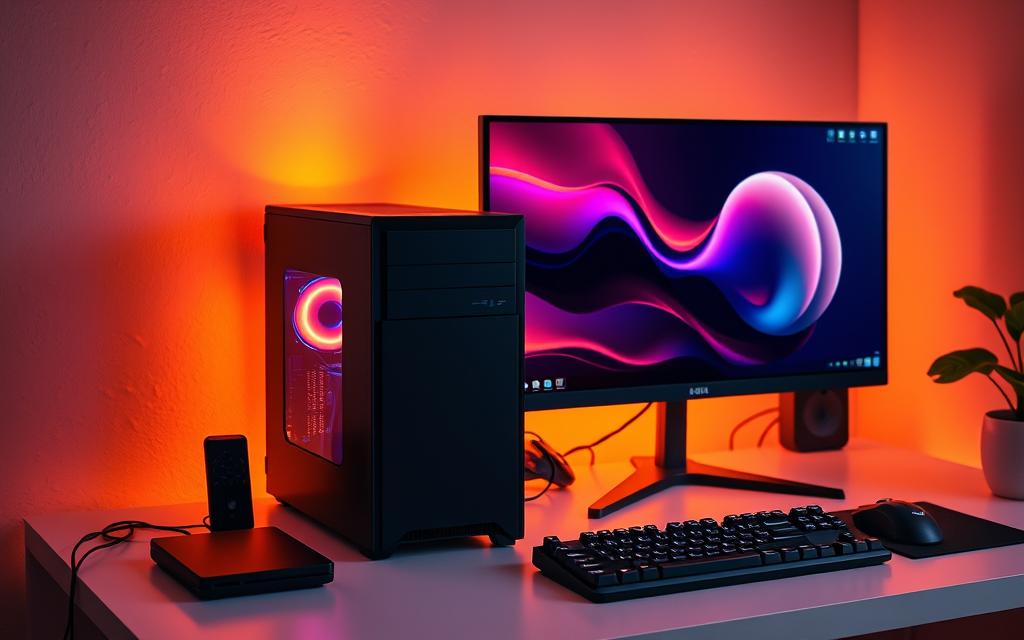
When comparing CPUs, the AMD Ryzen 5 8600G and Intel Core i5-14400F are popular choices. Both handle everyday gaming tasks efficiently, but the Ryzen 5 excels in multitasking due to its integrated graphics. For GPUs, the RTX 3050 and RX 7600 XT offer excellent value, with the latter providing better frame rates in demanding titles.
Storage is another critical factor. A minimum of 512GB SSD is recommended to ensure fast load times and smooth operation. RAM configurations vary, with 8GB being the baseline and 16GB offering better multitasking capabilities. However, budget cases often limit upgrade options, so choose wisely.
Thermal performance in compact builds can be a concern. Proper airflow and cooling solutions are essential to prevent overheating. Prebuilt systems often come with OEM bloatware, which can affect performance. Removing unnecessary software is a quick fix.
Real-world benchmarks for games like Fortnite and Apex Legends show that entry-level PCs can handle these titles at medium to high settings. Warranty support varies by brand, with some offering better coverage than others. Always check the terms before purchasing.
| Component | Recommendation |
|---|---|
| CPU | AMD Ryzen 5 8600G or Intel Core i5-14400F |
| GPU | RTX 3050 or RX 7600 XT |
| Storage | 512GB SSD minimum |
| RAM | 8GB (16GB recommended) |
| Thermal | Ensure proper airflow |
Mid-Range Gaming PCs: Balancing Cost and Performance
Mid-range gaming rigs strike the perfect balance between affordability and high-end features. Systems like the HP Omen 35L at $1,490 deliver 1440p/144Hz gameplay, catering to both competitive and immersive titles. This tier maximizes performance without the premium price tag.
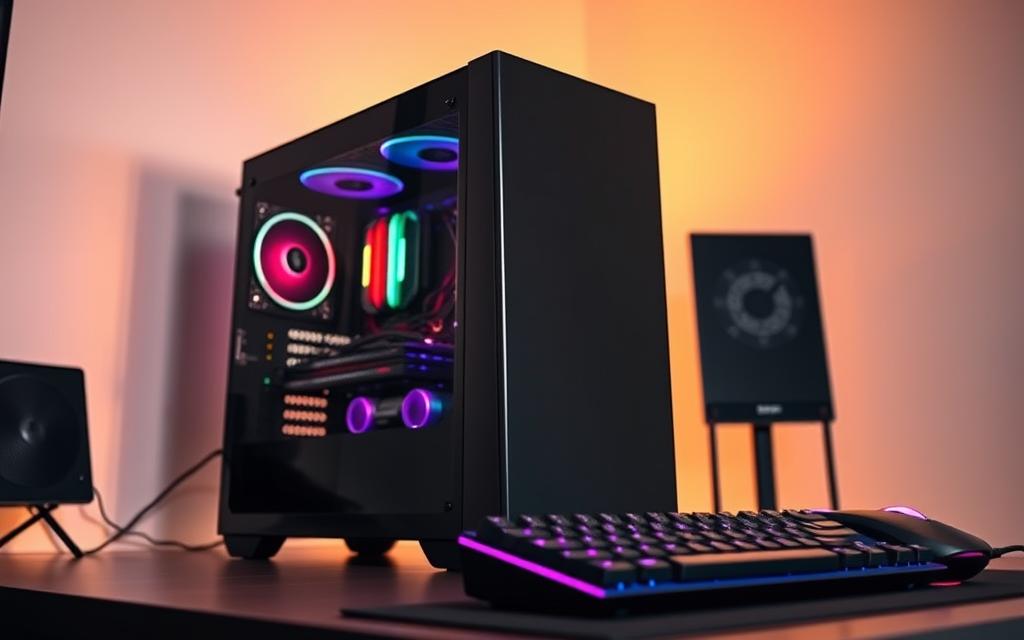
GPU choices define the experience. The GeForce RTX 4070 Super edges out AMD’s RX 7800 XT in ray tracing, while the latter offers better raw power for non-RT titles. Both handle 1440p smoothly, but driver stability varies by game.
RAM upgrades show tangible gains. DDR5-6000 boosts frame rates by 8–12% over DDR4-3600 in CPU-bound scenarios. For content creators, NVMe RAID 0 configurations slash render times, though backups are critical.
| Component | Recommendation |
|---|---|
| Cooling | AIO liquid for overclocking; air for budget-focused builds |
| Motherboard | Prioritize VRM quality (e.g., MSI B760 Tomahawk) |
| Noise Levels | Mid-tower cases like Fractal Design Meshify C balance airflow and acoustics |
Streaming demands extra system resources. The RTX 4070 Super’s NVENC encoder outperforms software solutions, keeping FPS drops below 5%. Multi-monitor setups require at least 12GB VRAM for consistent performance.
Extended warranties differ widely. Brands like ASUS offer 3-year coverage, while others limit support. Weigh costs against reliability—some components fail within 18 months.
“Mid-range builds dominate 2025’s market, offering 90% of high-end performance at half the cost.”
High-End Gaming PCs: Premium Performance at a Price
High-end gaming PCs in 2025 redefine what’s possible in immersive gameplay. These systems deliver performance that pushes boundaries, whether you’re gaming at 4K/120Hz or exploring 8K/60Hz visuals. For enthusiasts, the investment is justified by the sheer power and future-proofing these rigs offer.
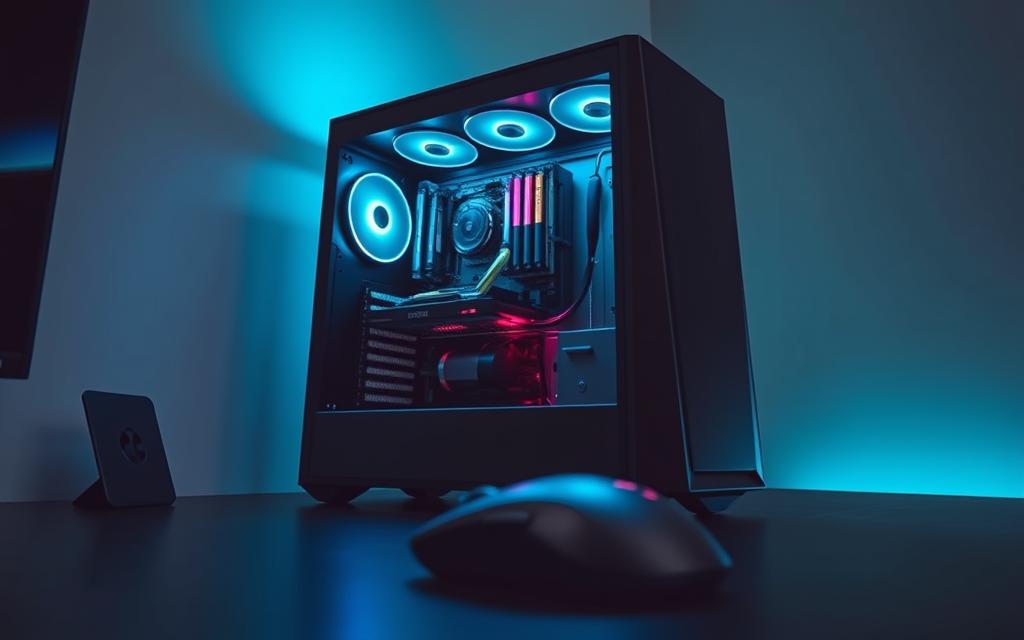
The NVIDIA GeForce RTX 4090 remains a standout, offering unmatched ray tracing and DLSS capabilities. In contrast, AMD’s RX 7900 XTX excels in raw rasterization performance, making it a strong contender for non-RT titles. Both GPUs handle the latest AAA games with ease, but the choice depends on your gaming priorities.
When it comes to CPUs, the AMD Threadripper PRO and Intel Core i9-14900K cater to different use cases. The Threadripper PRO shines in multitasking and content creation, while the Core i9-14900K dominates in gaming performance. Pairing these processors with custom loop liquid cooling ensures optimal thermal management, even during intense sessions.
PCIe 5.0 x16 bandwidth is another game-changer, enabling faster data transfer and reducing bottlenecks. High-end builds often require 1000W+ PSUs to support these components, ensuring stable power delivery. Boutique builders like Origin PC and Falcon Northwest offer premium systems like the Velocity Micro Raptor Z95 ($2,339) and Alienware Aurora R16 ($3,199), each with unique features.
For streamers, workstation-grade components are essential. Benchmarks in Blender and Premiere Pro show significant gains with high-end GPUs and CPUs. RGB lighting customization ecosystems, like Corsair iCUE, add a personal touch to your system, blending aesthetics with functionality.
“High-end gaming PCs aren’t just about raw power—they’re about delivering an experience that feels next-level.”
Whether you’re a competitive gamer or a content creator, these rigs offer the tools to excel. With the right components, your system can handle anything 2025 throws at it.
Future Trends in Gaming PC Technology
The gaming industry continues to evolve, with 2025 bringing groundbreaking advancements in hardware and software. From faster memory to AI-driven innovations, the future of gaming PCs is set to redefine performance and user experience.
One of the most anticipated developments is the rollout of GDDR7 memory. Expected to offer speeds up to 36 Gbps, GDDR7 will significantly enhance GPU performance, particularly for high-resolution gaming and multitasking. This upgrade will complement next-gen GPUs like the GeForce RTX 50-series, ensuring smoother gameplay and faster data processing.
Another game-changer is the adoption of the PCIe 6.0 interface. With double the bandwidth of PCIe 5.0, this technology will reduce bottlenecks in data transfer, enabling faster storage and GPU performance. Paired with PCIe 5.0 SSDs, systems will achieve unprecedented speeds, making load times virtually nonexistent.
AI-accelerated upscaling technologies are also gaining traction. NVIDIA’s DLSS 4.0 and AMD’s FSR 3.0 leverage machine learning to enhance image quality and frame rates without compromising performance. These innovations are particularly beneficial for 4K and 8K gaming, where power supply and cooling demands are higher.
Modular power supply units (PSUs) are becoming more popular, offering flexibility and efficiency. These PSUs allow users to customize cable configurations, reducing clutter and improving airflow. Additionally, sustainable manufacturing initiatives are driving the production of eco-friendly components, minimizing the environmental impact of gaming hardware.
Holographic cooling solutions are emerging as a futuristic alternative to traditional methods. By using light-based cooling, these systems reduce heat more efficiently, extending the lifespan of components. Meanwhile, M.2 SSDs are expected to reach capacities of 16TB+, providing ample storage for large game libraries and media files.
| Technology | Impact |
|---|---|
| GDDR7 Memory | Faster GPU performance, higher resolutions |
| PCIe 6.0 Interface | Reduced data transfer bottlenecks |
| AI Upscaling | Enhanced image quality, higher frame rates |
| Modular PSUs | Improved efficiency, customizable setups |
| Holographic Cooling | Efficient heat reduction, longer component life |
Optical interconnects are another exciting development, offering faster data transmission between motherboard components. This technology is particularly beneficial for high-performance systems, reducing latency and improving overall responsiveness.
ARM architecture is also making its way into gaming PCs, offering energy-efficient alternatives to traditional x86 processors. While adoption is still in its early stages, ARM-based systems could revolutionize portable gaming and low-power setups.
“The future of gaming PCs lies in balancing performance with sustainability, ensuring that advancements benefit both users and the environment.”
Finally, quantum computing co-processors are being explored for their potential to handle complex calculations in real-time. While still experimental, this technology could transform gaming physics and AI interactions, creating more immersive experiences.
Energy Efficiency and Gaming PCs
Energy efficiency is a critical factor for modern gaming PCs in 2025. With monthly energy costs ranging from $10 to $20, optimizing power usage can save gamers money while reducing environmental impact. Systems typically consume 300-500 watts, making it essential to choose energy-efficient components.
One way to improve efficiency is by selecting a power supply with 80 Plus certification. Gold and Titanium tiers offer the best performance, with Titanium achieving up to 94% efficiency under load. Undervolting GPUs is another effective strategy, balancing power consumption and performance without sacrificing frame rates.
Innovative solutions like solar-powered gaming setups are gaining traction. These systems use renewable energy to offset electricity usage, though initial setup costs can be high. EU energy efficiency regulations are also pushing manufacturers to develop greener components, ensuring compliance with stricter standards.
- Idle Power Consumption: Modern PCs consume less energy when idle, thanks to improved sleep states.
- Cooling Efficiency: Liquid cooling outperforms air cooling in managing heat, reducing the need for additional fans.
- Smart Power Strips: These devices cut power to peripherals when not in use, saving energy.
Heat recycling solutions are another emerging trend. By repurposing waste heat, these systems improve overall efficiency. ROI calculations show that investing in energy-efficient upgrades pays off within 1-2 years, making them a smart choice for any budget.
“Energy efficiency isn’t just about saving money—it’s about creating sustainable gaming systems for the future.”
Prebuilt vs. Custom Gaming PCs
Choosing between prebuilt and custom gaming PCs involves weighing several factors. Prebuilt systems, like the HP Omen 35L, offer convenience and comprehensive warranties. However, custom builds often provide better value and flexibility, allowing you to tailor the system to your exact needs.
Warranty coverage differs significantly. Prebuilt PCs typically come with full brand warranties, while custom builds rely on individual components warranties. This can affect long-term reliability and repair costs.
Build time is another consideration. Prebuilt systems are ready to use, saving time. Custom builds, though time-consuming, often result in cost savings and a deeper understanding of your system.
Proprietary components in prebuilt PCs can limit upgrades. Custom builds, on the other hand, allow for easy future upgrades. This flexibility ensures your gaming pcs remain relevant longer.
Boutique builders like Falcon Northwest offer high-end customization. These systems combine the convenience of prebuilt PCs with the flexibility of custom builds. However, they often come at a premium.
OEM systems frequently include bloatware, which can affect performance. Custom builds avoid this issue, providing a cleaner, more efficient setup. Cable management standards also vary, with custom builds offering better organization.
Technical support response times are faster for prebuilt systems. Custom builds may require troubleshooting individual components, which can be time-consuming. Component binning practices also differ, affecting overall performance.
Total cost of ownership comparisons reveal that custom builds are often more cost-effective choice in the long run. While prebuilt systems have higher upfront costs, custom builds offer better value through flexibility and upgradeability.
“Custom builds empower gamers to create a system tailored to their exact needs, offering unmatched flexibility and long-term value.”
Ultimately, the choice depends on your priorities. Prebuilt systems are ideal for those who value convenience, while custom builds cater to enthusiasts seeking control and customization.
Best Brands for Gaming PCs in 2025
Selecting the right brand for your gaming PC in 2025 ensures top-tier performance and reliability. With numerous options available, understanding the strengths of each manufacturer helps you make an informed decision.
Alienware continues to lead with its Aurora R16, known for sleek designs and powerful components. Their focus on cooling innovations ensures stable performance during intense gaming sessions. Alienware’s customer support is also a standout feature, offering peace of mind for long-term use.
MSI stands out with its Codex R2, delivering excellent value for mid-range budgets. Their system integration ensures seamless compatibility between parts, making it a favorite among gamers. MSI’s commitment to durability and performance makes it a reliable choice.
HP’s Omen series remains a top contender, offering robust warranty support and user-friendly designs. Their prebuilt systems are ideal for those who prioritize convenience without compromising on quality. HP’s attention to detail in thermal management ensures efficient cooling.
Velocity Micro excels in build quality, with custom solutions tailored to specific needs. Their attention to craftsmanship and premium materials sets them apart. For gamers seeking a personalized touch, Velocity Micro delivers exceptional results.
Corsair is renowned for its compact solutions, perfect for space-conscious setups. Their One i500 series combines power and efficiency in a sleek package. Corsair’s focus on energy-efficient components appeals to eco-conscious gamers.
Asus ROG offers innovative mini-PC options, ideal for portable gaming. Their compact designs don’t sacrifice performance, making them a versatile choice. Asus’s reputation for reliability ensures long-term satisfaction.
Origin PC and Falcon Northwest cater to enthusiasts with unparalleled customization options. Their boutique builds emphasize craftsmanship and attention to detail. These brands are perfect for gamers who want a unique, high-performance system.
When comparing boutique and mainstream brands, boutique options often provide better customization and craftsmanship. Mainstream brands, however, offer broader support networks and accessibility. Both have their merits, depending on your priorities.
“Choosing the right brand ensures your gaming PC meets your needs today and remains relevant in the future.”
Reliability rankings place Alienware and MSI at the top for mainstream options, while Velocity Micro and Falcon Northwest lead in boutique categories. Ultimately, the best brand depends on your budget, preferences, and gaming goals.
Budgeting for a Gaming PC in 2025
Planning your gaming PC budget in 2025 requires careful consideration of costs and upgrades. With systems ranging from $1,000 to $4,000, smart allocation ensures long-term value. A 50/30/20 model can help: 50% for core components, 30% for upgrades, and 20% for maintenance and energy costs.
Component upgrade roadmaps are essential. Prioritize GPUs and CPUs, as they depreciate slower than RAM or storage. Seasonal sales, like Black Friday, can save up to 20% on parts. DIY builds often cost 5-15% less than prebuilt systems, offering better flexibility.
Credit financing options are available for high-end builds. However, interest rates can add to the overall cost. Recycling old components can offset expenses, with GPUs retaining up to 40% of their value after two years.
Extended warranties vary by brand. Comprehensive coverage adds 10-15% to the initial price but ensures peace of mind. Subscription services, like NVIDIA GeForce NOW, reduce upfront costs but require ongoing payments.
“Smart budgeting balances immediate needs with future-proofing, ensuring your system remains relevant for years.”
Emergency repair funds are crucial. Allocate 5-10% of your budget for unexpected issues, like PSU failures or cooling system replacements. Monthly energy costs average $10-$20, so investing in efficient components pays off over time.
| Budget Category | Allocation |
|---|---|
| Core Components | 50% |
| Upgrades | 30% |
| Maintenance & Energy | 20% |
By following these strategies, you can build a gaming PC that meets your needs without breaking the bank. Smart planning ensures you get the most out of your investment.
Where to Buy a Gaming PC in 2025
Finding the right place to purchase a gaming PC in 2025 is crucial for getting the best value. With options ranging from online retailers to local builders, understanding the pros and cons of each can help you make an informed decision.
Online retailers like Amazon and B&H Photo offer convenience and competitive pricing. However, their return policies vary. Amazon provides a 30-day return window, while B&H Photo offers extended support for certain components. Always check the fine print before purchasing.
Manufacturer direct sales from Dell and HP often include refurbished programs. These systems are rigorously tested and come with warranties, making them a cost-effective choice. Local PC builder networks are another option, offering personalized service and support tailored to your home setup.
Microcenter’s bundle deals are worth exploring. They often combine system parts at discounted rates, saving you money. However, auction sites like eBay come with risks. While you might find rare components, counterfeit products are a concern. Always verify seller ratings and reviews.
Import taxes can add to the cost when buying internationally. Shipping insurance is another factor to consider, especially for high-value items. Assembly service providers are available for those who prefer a ready-to-use gaming PC, though this adds to the overall expense.
Payment plans are increasingly popular, with retailers offering installment options. This can make high-end builds more accessible. To avoid counterfeit products, purchase from reputable brands and verify authenticity through official channels.
| Option | Pros | Cons |
|---|---|---|
| Online Retailers | Convenience, competitive pricing | Varying return policies |
| Manufacturer Direct | Refurbished programs, warranties | Limited customization |
| Local Builders | Personalized service, support | Higher upfront cost |
| Microcenter Bundles | Discounted rates, value deals | Limited availability |
| Auction Sites | Rare components, potential deals | Counterfeit risks |
“Choosing the right place to buy ensures you get the best value and support for your gaming PC.”
By weighing these options, you can find the perfect place to purchase your gaming PC in 2025. Whether you prioritize cost, convenience, or customization, there’s a solution for every gamer.
Conclusion
Building a gaming setup in 2025 requires balancing performance, budget, and future-proofing strategies. Entry-level systems start around $500, while high-end rigs can exceed $4,000. Each tier offers unique value, ensuring options for every gamer.
Emerging technologies like GDDR7 memory and PCIe 6.0 are reshaping the landscape. These advancements enhance speed and efficiency, making it essential to invest wisely. Proper budgeting ensures long-term value, with upgrades and energy efficiency playing key roles.
Brands like Alienware and MSI stand out for their reliability and innovation. Custom builds offer flexibility, while prebuilt systems provide convenience. Regardless of choice, prioritizing quality components ensures a seamless experience.
By focusing on value, sustainability, and informed decisions, gamers can create setups that deliver exceptional performance without breaking the bank. The future of gaming PCs is bright, offering endless possibilities for enthusiasts.
FAQ
How much does a solid gaming PC cost in 2025?
The cost varies based on performance needs, but a reliable setup typically ranges from 0 to ,000+. Entry-level builds start around 0-
FAQ
How much does a solid gaming PC cost in 2025?
The cost varies based on performance needs, but a reliable setup typically ranges from $800 to $3,000+. Entry-level builds start around $800-$1,200, while high-end systems with top-tier components like an RTX 4070 Super or Intel Core Ultra CPU can exceed $3,000.
What components impact performance the most?
The GPU (e.g., NVIDIA RTX 4070) and CPU (e.g., Intel Core Ultra) are critical for gaming. RAM (16GB+) and fast storage (NVMe SSDs) also enhance speed and load times. A quality power supply and motherboard ensure stability.
Is a prebuilt or custom PC better for gaming?
Prebuilt PCs offer convenience and warranties, while custom builds allow tailored performance and upgrades. Brands like ASUS, Alienware, and NZXT provide strong prebuilt options, but DIY setups often deliver better value.
How important is the size of the desktop?
Case size affects airflow, component compatibility, and portability. A mid-tower balances space and flexibility, while small-form-factor (SFF) builds suit compact setups. Ensure the case fits your GPU and cooling needs.
Will a budget PC run modern games smoothly?
Yes! A $1,000-$1,500 rig can handle most games at 1080p/60fps with mid-tier GPUs like the RTX 4060. Adjusting settings (e.g., lowering shadows, textures) can boost frame rates on tighter budgets.
What’s the best monitor for a gaming setup?
Pair your system with a 144Hz+ monitor for smooth gameplay. 1080p suits budget builds, while 1440p or 4K enhances visuals for those with RTX 4070-level GPUs. Ensure adaptive sync (G-Sync) compatibility.
How often should I upgrade my gaming PC?
Every 3-5 years for major components (GPU/CPU). Smaller upgrades like RAM or storage can extend longevity. Future-proofing with a strong motherboard and power supply helps delay full overhauls.
Are SSDs necessary for gaming?
Yes! NVMe SSDs drastically reduce load times versus HDDs. A 1TB SSD is ideal for OS and games, while a secondary HDD can store additional files affordably.
,200, while high-end systems with top-tier components like an RTX 4070 Super or Intel Core Ultra CPU can exceed ,000.
What components impact performance the most?
The GPU (e.g., NVIDIA RTX 4070) and CPU (e.g., Intel Core Ultra) are critical for gaming. RAM (16GB+) and fast storage (NVMe SSDs) also enhance speed and load times. A quality power supply and motherboard ensure stability.
Is a prebuilt or custom PC better for gaming?
Prebuilt PCs offer convenience and warranties, while custom builds allow tailored performance and upgrades. Brands like ASUS, Alienware, and NZXT provide strong prebuilt options, but DIY setups often deliver better value.
How important is the size of the desktop?
Case size affects airflow, component compatibility, and portability. A mid-tower balances space and flexibility, while small-form-factor (SFF) builds suit compact setups. Ensure the case fits your GPU and cooling needs.
Will a budget PC run modern games smoothly?
Yes! A
FAQ
How much does a solid gaming PC cost in 2025?
The cost varies based on performance needs, but a reliable setup typically ranges from $800 to $3,000+. Entry-level builds start around $800-$1,200, while high-end systems with top-tier components like an RTX 4070 Super or Intel Core Ultra CPU can exceed $3,000.
What components impact performance the most?
The GPU (e.g., NVIDIA RTX 4070) and CPU (e.g., Intel Core Ultra) are critical for gaming. RAM (16GB+) and fast storage (NVMe SSDs) also enhance speed and load times. A quality power supply and motherboard ensure stability.
Is a prebuilt or custom PC better for gaming?
Prebuilt PCs offer convenience and warranties, while custom builds allow tailored performance and upgrades. Brands like ASUS, Alienware, and NZXT provide strong prebuilt options, but DIY setups often deliver better value.
How important is the size of the desktop?
Case size affects airflow, component compatibility, and portability. A mid-tower balances space and flexibility, while small-form-factor (SFF) builds suit compact setups. Ensure the case fits your GPU and cooling needs.
Will a budget PC run modern games smoothly?
Yes! A $1,000-$1,500 rig can handle most games at 1080p/60fps with mid-tier GPUs like the RTX 4060. Adjusting settings (e.g., lowering shadows, textures) can boost frame rates on tighter budgets.
What’s the best monitor for a gaming setup?
Pair your system with a 144Hz+ monitor for smooth gameplay. 1080p suits budget builds, while 1440p or 4K enhances visuals for those with RTX 4070-level GPUs. Ensure adaptive sync (G-Sync) compatibility.
How often should I upgrade my gaming PC?
Every 3-5 years for major components (GPU/CPU). Smaller upgrades like RAM or storage can extend longevity. Future-proofing with a strong motherboard and power supply helps delay full overhauls.
Are SSDs necessary for gaming?
Yes! NVMe SSDs drastically reduce load times versus HDDs. A 1TB SSD is ideal for OS and games, while a secondary HDD can store additional files affordably.
,000-
FAQ
How much does a solid gaming PC cost in 2025?
The cost varies based on performance needs, but a reliable setup typically ranges from $800 to $3,000+. Entry-level builds start around $800-$1,200, while high-end systems with top-tier components like an RTX 4070 Super or Intel Core Ultra CPU can exceed $3,000.
What components impact performance the most?
The GPU (e.g., NVIDIA RTX 4070) and CPU (e.g., Intel Core Ultra) are critical for gaming. RAM (16GB+) and fast storage (NVMe SSDs) also enhance speed and load times. A quality power supply and motherboard ensure stability.
Is a prebuilt or custom PC better for gaming?
Prebuilt PCs offer convenience and warranties, while custom builds allow tailored performance and upgrades. Brands like ASUS, Alienware, and NZXT provide strong prebuilt options, but DIY setups often deliver better value.
How important is the size of the desktop?
Case size affects airflow, component compatibility, and portability. A mid-tower balances space and flexibility, while small-form-factor (SFF) builds suit compact setups. Ensure the case fits your GPU and cooling needs.
Will a budget PC run modern games smoothly?
Yes! A $1,000-$1,500 rig can handle most games at 1080p/60fps with mid-tier GPUs like the RTX 4060. Adjusting settings (e.g., lowering shadows, textures) can boost frame rates on tighter budgets.
What’s the best monitor for a gaming setup?
Pair your system with a 144Hz+ monitor for smooth gameplay. 1080p suits budget builds, while 1440p or 4K enhances visuals for those with RTX 4070-level GPUs. Ensure adaptive sync (G-Sync) compatibility.
How often should I upgrade my gaming PC?
Every 3-5 years for major components (GPU/CPU). Smaller upgrades like RAM or storage can extend longevity. Future-proofing with a strong motherboard and power supply helps delay full overhauls.
Are SSDs necessary for gaming?
Yes! NVMe SSDs drastically reduce load times versus HDDs. A 1TB SSD is ideal for OS and games, while a secondary HDD can store additional files affordably.
,500 rig can handle most games at 1080p/60fps with mid-tier GPUs like the RTX 4060. Adjusting settings (e.g., lowering shadows, textures) can boost frame rates on tighter budgets.
What’s the best monitor for a gaming setup?
Pair your system with a 144Hz+ monitor for smooth gameplay. 1080p suits budget builds, while 1440p or 4K enhances visuals for those with RTX 4070-level GPUs. Ensure adaptive sync (G-Sync) compatibility.
How often should I upgrade my gaming PC?
Every 3-5 years for major components (GPU/CPU). Smaller upgrades like RAM or storage can extend longevity. Future-proofing with a strong motherboard and power supply helps delay full overhauls.
Are SSDs necessary for gaming?
Yes! NVMe SSDs drastically reduce load times versus HDDs. A 1TB SSD is ideal for OS and games, while a secondary HDD can store additional files affordably.


